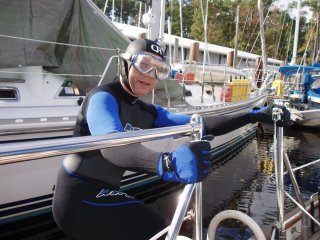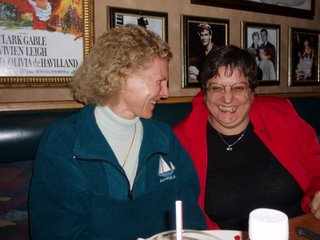
 On Saturday, November 11, we sailed back to Norfolk. Larry had gotten the engine working again, and we had a very nice south-west breeze to sail back with. The sun was setting as we spotted the entrance buoys to the inlet, and we motored the long way back in the inlet in the dark. The weather forecast was for south and east winds of 20-25 knots after midnight into the next day, so we anchored in the south-east corner of Willoughby Bay to get protection from the winds forecast. We dropped anchor just before midnight, let out 90 feet of anchor chain, and battened everything down for a breezy night.
On Saturday, November 11, we sailed back to Norfolk. Larry had gotten the engine working again, and we had a very nice south-west breeze to sail back with. The sun was setting as we spotted the entrance buoys to the inlet, and we motored the long way back in the inlet in the dark. The weather forecast was for south and east winds of 20-25 knots after midnight into the next day, so we anchored in the south-east corner of Willoughby Bay to get protection from the winds forecast. We dropped anchor just before midnight, let out 90 feet of anchor chain, and battened everything down for a breezy night.The wind, when it came up, was instead from the northwest, blowing directly across the bay, allowing the waves to build. By mid-morning it was a full gale of 35-40 knots, blowing sheets of rain across us. Our anchor was holding well, but it was a wild ride. It did not start subsiding until Monday morning, when the wind was down to about 15-20 knots, with a steel-gray sky. We decided to pull up our anchor and get going down to the boatyard.
The force of the wind and water on the anchor was hard to describe; in hindsight, we should have waited one more day for the wind to die down before moving. Using the engine to help motor up to the anchor, and our windlass, Larry tried to get the anchor up. The bow roller that guides the anchor chain started to flex as the chain came in, something we had never seen before. Finally the roller twisted into the shape pictured above. Larry also got his hand caught between the chain and the post, crushing a finger, even as careful as he could be. Things just happen very quickly when the wind is blowing. He could have lost a finger very easily. The anchor wouldn't come up, when we came to the end of the chain; it was solidly set and wouldn't budge.
At that point we were in a real predicament. The roller was compromised and could shear off at any moment; the bow of the boat was bucking like a bronco; and we knew if the roller came off, the anchor chain would start to take out the bow of the boat. We could lose the boat quite easily. We tried to hail TowBoat/US on the VHF radio, but they didn't answer. Neither did anyone else. So, we used the ham radio to contact Maritime Radio 14300 KHz, who saved the day. They contacted TowBoat/US for us and put us in a patch via the radio to them. It turns out they were on another emergency call and couldn't get to us for over 2 hours. So we braced the bow as well as we could and waited. Finally, the motion of the boat broke the anchor free, and we carefully raised it and lashed the anchor in the twisted roller.
We held our breath with every rolling wave that washed over us and motored down to Great Bridge. In the morning, the boatyard was extremely accomodating, cleaning up the diesel in our bilge, and even replacing our bow roller. We also had their machine shop put a steel plate to reinforce the bow roller.
Things could have been much worse, as we read up on bow rollers and their vulnerabilities and importance in an anchoring system. We got several good lessons in safety at very little cost.
















